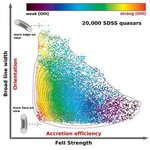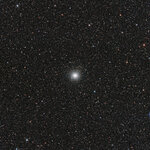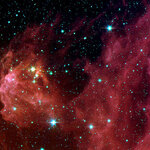Space

“Hot Jupiters” are the term for large, gaseous exoplanets in other solar systems and a new study finds they make their suns wobble as they make their way through their orbit.
Jupiters are a nice designation for a metric because it has a mass 1/1000th of that of the Sun
In our solar system, the sun’s rotational axis is approximately aligned with the orbital axis of all the planets. The orbital axis is perpendicular to the flat plane in which the planets revolve around the sun. In solar systems with hot Jupiters, observations have revealed that the orbital axis of these planets is…

Researchers planted 4,200 seeds in soils expected to mimic those in potential greenhouses on Mars and on the moon. Courtesy of Wieger Wamelink http://on.fb.me/1rYkF8p
By Patricia Waldron, Inside Science
(Inside Science) -- Any explorers visiting Mars and the moon will have to boldly grow where no man has grown before.
Setting up lunar or Martian colonies will require that explorers raise their own food. New research finds that simulated Martian soil supported plant life better than both simulated moon soil and low-quality soil from Earth. But many problems must be solved before astronauts can…

Tonight due to powerful X-class solar flares earlier this week we may get to see the Aurora Borealis at latitudes where it usually is not visible. The Northern Lights are the result of charged particles from the Sun interacting with Earth's magnetic field. They ride the lines of magnetic force towards the north and south pole and release light as their acceleration changes.
This is one of the most beautiful sights in nature. A view of the Aurora Australis from the international space station.
Why can't we see these in the 48 Contiguous United States of…

Tonight due to powerful X-class solar flares earlier this week we may get to see the Aurora Borealis at latitudes where it usually is not visible. The Northern Lights are the result of charged particles from the Sun interacting with Earth's magnetic field. They ride the lines of magnetic force towards the north and south pole and release light as their acceleration changes.
This is one of the most beautiful sights in nature. A view of the Aurora Australis from the international space station.
Why can't we see these in the 48 Contiguous United States of…

Venus is uninhabitable for humans yet from a distance, using statistical wobbles, a Venus-like planet and an Earth-like planet are very similar.
While the Earth has oceans of water and relatively moderate temperatures, Venus has no liquid
water and exists in a runaway greenhouse scenario where the levels of carbon dioxide are so high that the atmosphere traps all the heat. The planet is torrid but it is 95 percent the size of Earth. Right now, size is what astronomers are looking for when searching for exoplanets but size alone is not a distinguishing characteristic when sorting for a…

Quasars are supermassive black holes that live at the center of distant galaxies. They are the most luminous beacons in the sky, and shine across the entire electromagnetic spectrum due to rapidly accreting matter in their gravitationally inescapable centers.
Quasars display a broad range of outward appearances when viewed by astronomers, reflecting the diversity in the conditions of the regions close to their centers. But despite this variety, quasars have a surprising amount of regularity in their quantifiable physical properties, which follow well-defined trends (referred to as the "main…

The Milky Way galaxy is orbited by more than 150 globular star clusters - balls of hundreds of thousands of old stars dating back to the formation of the galaxy. In the constellation of Sagittarius (The Archer), the French comet hunter Charles Messier found one such cluster and it was given the designation Messier 54.
For more than two hundred years after its discovery Messier 54, was thought to be similar to the other Milky Way globulars, but in 1994 astronomers determined that it was actually associated with a separate galaxy — the Sagittarius Dwarf Galaxy. It was found to be at a distance…

The minor controversy over whether the 38 foot wide gouge near Managua Nicaragua is a impact crater leads me to the question, how easy is it to tell by sight alone if something is an impact crater or not? So let's play crater or not crater.
To find the answer click the pictures and there will be a link to a source which shows that one image is a impact crater or not impact crater. That is in cases where it's uncontroversially clear.
The first candidate. 1
2. Now the second one.
3. The third candidate impact crater
4. The fourth candidate impact feature (C'…

The Orion Nebula. Image credit: NASA http://bit.ly/1rTTyeC
By: Marcus Woo, Inside Science
(Inside Science) -- Interstellar space can be a dusty place, filled with tiny flecks no bigger than a bacterial cell.
But now astronomers have detected particles as big as pebbles, possibly a previously unknown type of dust that may kick-start the production of planets. The presence of these big particles may also suggest that star formation is more efficient than previously thought.
Astronomers know that large particles gather in the dense disks of gas and dust that surround newborn stars. Those…

Asteroid 2014 RC will buzz the Earth today. But don't be alarmed.
The small asteroid was initially discovered on the night of August 31st by the Catalina Sky Survey near Tucson, AZ, and independently detected the next night by the Pan-STARRS 1 telescope, located on the summit of Haleakala on Maui, Hawaii. Both reported their observations to the Minor Planet Center in Cambridge, MA. Additional follow-up observations by the Catalina Sky Survey and the University of Hawaii 88-inch on Mauna Kea confirmed the orbit of 2014 RC. From its brightness, astronomers estimate that the asteroid is…